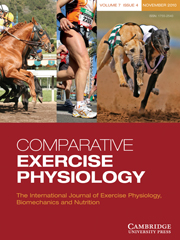Article contents
Linear and temporal changes in the trot of 2-year-old Thoroughbred racehorses in relation to early exercise and race training
Published online by Cambridge University Press: 14 July 2010
Abstract
The assessment of the effect of race training on the locomotory apparatus can be confounded by tissue responses to the increasing training load, such as dorsal metacarpal disease. The aim of this paper was to examine the changes in gait during the early stage of race training in a cohort of 19.2-year-old Thoroughbreds, 11 of which had previously been exposed to spontaneous pasture exercise and also to preconditioning exercise from an early age (CONDEX), and the remainder had been exposed to only spontaneous pasture exercise (PASTEX). Data were collected 52, 60, 77, 109 and 176 days after the horses had entered the racing stable. At each examination, the horses were trotted in-hand on a hard asphalt surface, and kinematic data were collected. The horses trotted slowest on the first examination day, with a significantly longer and slower stride and associated percentage stance time. On day 77, the CONDEX horses trotted faster, had a longer stride length and achieved mid-stance earlier than the PASTEX horses. Across both groups, the introduction of galloping was associated with a significant reduction in stride duration (0.69 ± 0.01 vs. 0.66 ± 0.01 s, P = 0.001), stride length (2.49 ± 0.03 vs. 2.38 ± 0.02 m, P = 0.004) and stance duration (27.3 ± 1.0 vs. 32.0 ± 1.0%, P = 0.001). The changes in gait appeared to be associated with the introduction of galloping and the associated tolerance of the CONDEX group to the musculoskeletal loading.
Information
- Type
- Research Paper
- Information
- Copyright
- Copyright © Cambridge University Press 2010
References
- 4
- Cited by

